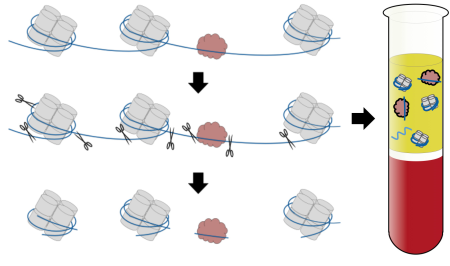
Caption: DNA (blue) loops around nucleosomes (gray) and is bound by transcription factors (red), proteins that switch genes on and off and act in a tissue-specific manner. When cells die, enzymes (scissors) chop up areas between the nucleosomes and transcription factors, releasing DNA fragments in unique patterns. By gathering the released DNA fragments in blood, researchers can tell which types of cells produced them.
Credit: Shendure Lab/University of Washington
Credit: Shendure Lab/University of Washington
From Genomics & Health Impact Scan Database
This database includes published scientific literature on evidence-based translation of genomic discoveries into improved health care and disease prevention that have a potential impact on population health.
- Concordance between Comprehensive Cancer Genome Profiling in Plasma and Tumor Specimens.

Müller Judith N et al. Journal of thoracic oncology : official publication of the International Association for the Study of Lung Cancer 2017 Oct 12(10) 1503-1511 - RAS testing of liquid biopsy correlates with the outcome of metastatic colorectal cancer patients treated with first-line FOLFIRI plus cetuximab in the CAPRI-GOIM trial.

Normanno N et al. Annals of oncology : official journal of the European Society for Medical Oncology 2017 Aug - Clinical Utility of Circulating Tumor DNA for Molecular Assessment and Precision Medicine in Pancreatic Cancer.

Takai Erina et al. Advances in experimental medicine and biology 2016 92413-17 - Clinical utility of KRAS status in circulating plasma DNA compared to archival tumour tissue from patients with metastatic colorectal cancer treated with anti-epidermal growth factor receptor therapy.

Spindler Karen-Lise Garm et al. European journal of cancer (Oxford, England : 1990) 2015 Oct - Noninvasive identification and monitoring of cancer mutations by targeted deep sequencing of plasma DNA.

Forshew T, et al. Science translational medicine 2012 5 (136) 136






















.png)









No hay comentarios:
Publicar un comentario